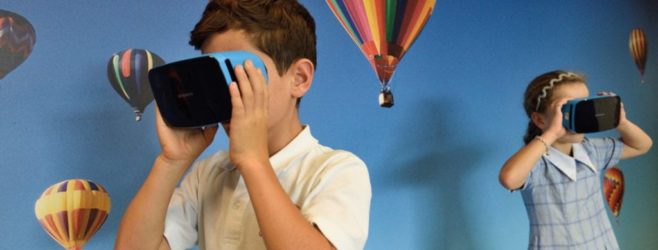Children with cerebral palsy suffer from limited motor function and mobility issues, but technology and therapy can be combined with virtual reality therapy to help kids develop their mobility.
Children with cerebral palsy struggle to control their movements because they experienced a brain injury at or around birth that affected their nervous system and muscle control. Many children with cerebral palsy see physical and occupational therapists as a standard treatment to strengthen their muscles and build up more control over their movements.
However, research is showing that there may be another tool parents and therapists can use. Virtual reality therapy (VRT) can help children with cerebral palsy improve their motor function.
Virtual Reality As Therapy and Rehabilitation
Virtual reality therapy uses interactive simulations to help children with cerebral palsy interact with objects and events that feel life-like. In VRT children play exergames—games that encourage exercising—to improve their physical fitness levels and motor skills through the use of repetitive actions.
One example of VRT is MoveHero. In this game, the child is manipulating their avatar—the digital version of themselves—to hit a falling ball. If the child can move their own arms in time for their avatar to hit the ball, they get a +1.
VRT is not only used to treat cerebral palsy. It has also been used to help treat individuals suffering from hemiparesis, or muscle weakness or partial paralysis on one side of the body. Hemiparesis can affect the arms, legs and facial muscles. Research from Tel Aviv University suggests that VRT can help patients improve their hand mobility and motor skills by letting them use their stronger hand to show their weaker side what to do.
VRT has also been used to treat patients who suffered from a hemiplegic stroke. In this study, the patients were divided into two groups: those who received traditional physical and occupational therapy and those who received virtual reality therapy. Regardless of which type of treatment the patients underwent, they improved their mobility the same amount by the three-month follow-up.
Virtual Reality Therapy for Cerebral Palsy
Virtual reality can be a great form of therapy for children with cerebral palsy because helps them improve their posture, increase their range of motion—like their ability to reach or grab—and strengthen their muscles. But, more than that, the therapy happens in the form of a game, so it is fun for the child.
Some of the other benefits of using VRT to treat cerebral palsy are:
- Allows children with cerebral palsy to practice at home with or without a professional therapist
- Allows children to tailor the duration, intensity and frequency of practice to their own needs
- Provides instant feedback
- Improves motor skills by engaging children with problem-solving tasks, which can increase neuroplasticity or brain-growth
- Makes therapy fun
- Offers social interaction through multi-player modes that encourage family and peer support
- Improves their motivation and confidence
While not all of the limitations of VRT are known, the hope for this therapy is to help children with cerebral palsy interact with other people and objects in the real world. VRT can assist children in overcoming any barriers that may be in their way.
Hope With Innovative Cerebral Palsy Therapies
Parents of children with cerebral palsy may find comfort in knowing that technology and research advancements are finding new and innovative ways to target aspects of cerebral palsy and improve children’s lives.
However, parents are still the top advocate for their child’s continued health and progress, so make sure you take time to learn more about therapy options for their kids, such as occupational, physical, speech and aquatic therapies.
If your child was diagnosed with cerebral palsy and you suspect it was as a result of medical negligence, contact Birth Injury Justice Center. Legal options exist to help you pay for cerebral palsy therapies and gain greater medical access to innovative treatments and clinical trials for children with cerebral palsy.



